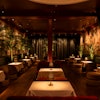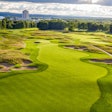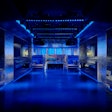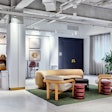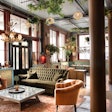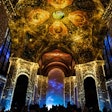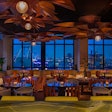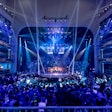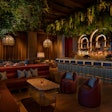This August, President Bush and other high-level Republicans will be at the top of dozens of guest lists, and their safety will be a top priority for planners hoping to host them during the Republican National Convention. "Security is the sex appeal topic" of the R.N.C., joked Bill Harris, C.E.O. of the convention, to a crowd of business leaders at a recent breakfast sponsored by the Association for a Better New York. More than 50,000 visitors—including Republican delegations from across the country and approximately 15,000 journalists—are headed to the city for the massive media circus and hundreds of related dinners, parties and protests. This all adds up to an enormous security conundrum for city and federal officials—and for event planners doing anything surrounding the convention.
Security for the convention itself will involve several organizations, including the N.Y.P.D., the Secret Service, the F.B.I. and the Office of Emergency Management. One Secret Service agent—who prefers to go unnamed—estimates that 10,000 N.Y.P.D. officers and 1,500 Secret Service agents will be in and around Madison Square Garden while the president is inside.
Plans to secure the Garden while the president is at the convention include delaying train traffic from entering Penn Station, or shutting Penn down completely. The agent adds: "While the president is in town, [the airspace above] Midtown Manhattan is a no-fly zone." Navy and Air Force fighter planes are stationed in the area to counter any planes that violate the airspace.
Venues preparing to host Bush and other high-level Republicans—including the Waldorf=Astoria (where the president will stay)—are installing security cameras, metal and motion detectors, X-ray machines and other preventative measures to beef up security.
The industry is also expecting an unprecedented level of security at events. While most hosts won't discuss their security plans in detail—if they've even made them yet—some recent post-September 11 events provide a glimpse at what's to come this summer.
When securing an event attended by the former prime minister of Israel, Alan Schissel, president of Integrated Security Services, worked with the Shin Bet, the Israeli Secret Service, to create a multilayered security plan inside the Waldorf to ensure against pre-planted poisons and explosives. "About a half-hour before the event, the grand ballroom was cleared of every single worker. [Bomb-sniffing] dogs went through the whole room, and we shuffled the deck. We took entire tables and switched them, and switched chairs around."
To guard against poisoned food, the Shin Bet created an area between the kitchen and the dining room to inspect plates of food going to the tables. The buffer zone kept the waitstaff from entering the kitchen, making it impossible for food preparers to know where specific plates of food were going.
Schissel has some advice for planners and vendors working on events that will involve the Secret Service. "Plan on identifying and having the pedigree [full name, date of birth and Social Security number] of every staff member that will be actively engaged with the event," he says.
"Time management is the most important.phpect of planning around a presidential visit," Schissel says. "Leave yourself room for trains being rerouted and traffic being diverted and streets being blocked off. Plan hours in advance of getting product and personnel to a location, knowing that the obstacle is going to be a team of Secret Service agents that [will make it] a difficult entrance."
Even planners who are working on non-R.N.C.-related events during the convention need to think about security, especially if they're using venues that might be hosting big-shot politicos in the next room. At a recent meeting of the International Special Events Society, one planner recounted a surprise during an event at the Waldorf: "Henry Kissinger was in the next room, and I didn't find out until after the event." Knowing who will be in the same venue at the same time can prevent some nasty surprises, especially if a guest next door comes with a large security detail—or a group of protestors.
All of the security measures around government officials are designed to maintain the appearance that they are safe, but not so safe that they're isolated. "They're public figures and must have the appearance of being accessible to the public, but at the same time being very secure," says Bill Haire, vice president of the International Protective Services Agency. "They have to appear accessible while you are trying to limit liability."
—Suzanne Ito
Posted 02.26.04
Security for the convention itself will involve several organizations, including the N.Y.P.D., the Secret Service, the F.B.I. and the Office of Emergency Management. One Secret Service agent—who prefers to go unnamed—estimates that 10,000 N.Y.P.D. officers and 1,500 Secret Service agents will be in and around Madison Square Garden while the president is inside.
Plans to secure the Garden while the president is at the convention include delaying train traffic from entering Penn Station, or shutting Penn down completely. The agent adds: "While the president is in town, [the airspace above] Midtown Manhattan is a no-fly zone." Navy and Air Force fighter planes are stationed in the area to counter any planes that violate the airspace.
Venues preparing to host Bush and other high-level Republicans—including the Waldorf=Astoria (where the president will stay)—are installing security cameras, metal and motion detectors, X-ray machines and other preventative measures to beef up security.
The industry is also expecting an unprecedented level of security at events. While most hosts won't discuss their security plans in detail—if they've even made them yet—some recent post-September 11 events provide a glimpse at what's to come this summer.
When securing an event attended by the former prime minister of Israel, Alan Schissel, president of Integrated Security Services, worked with the Shin Bet, the Israeli Secret Service, to create a multilayered security plan inside the Waldorf to ensure against pre-planted poisons and explosives. "About a half-hour before the event, the grand ballroom was cleared of every single worker. [Bomb-sniffing] dogs went through the whole room, and we shuffled the deck. We took entire tables and switched them, and switched chairs around."
To guard against poisoned food, the Shin Bet created an area between the kitchen and the dining room to inspect plates of food going to the tables. The buffer zone kept the waitstaff from entering the kitchen, making it impossible for food preparers to know where specific plates of food were going.
Schissel has some advice for planners and vendors working on events that will involve the Secret Service. "Plan on identifying and having the pedigree [full name, date of birth and Social Security number] of every staff member that will be actively engaged with the event," he says.
"Time management is the most important.phpect of planning around a presidential visit," Schissel says. "Leave yourself room for trains being rerouted and traffic being diverted and streets being blocked off. Plan hours in advance of getting product and personnel to a location, knowing that the obstacle is going to be a team of Secret Service agents that [will make it] a difficult entrance."
Even planners who are working on non-R.N.C.-related events during the convention need to think about security, especially if they're using venues that might be hosting big-shot politicos in the next room. At a recent meeting of the International Special Events Society, one planner recounted a surprise during an event at the Waldorf: "Henry Kissinger was in the next room, and I didn't find out until after the event." Knowing who will be in the same venue at the same time can prevent some nasty surprises, especially if a guest next door comes with a large security detail—or a group of protestors.
All of the security measures around government officials are designed to maintain the appearance that they are safe, but not so safe that they're isolated. "They're public figures and must have the appearance of being accessible to the public, but at the same time being very secure," says Bill Haire, vice president of the International Protective Services Agency. "They have to appear accessible while you are trying to limit liability."
—Suzanne Ito
Posted 02.26.04




